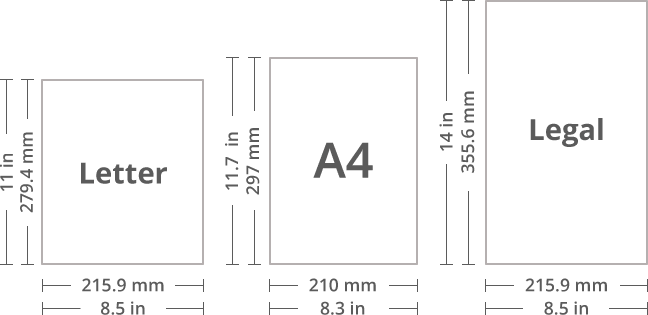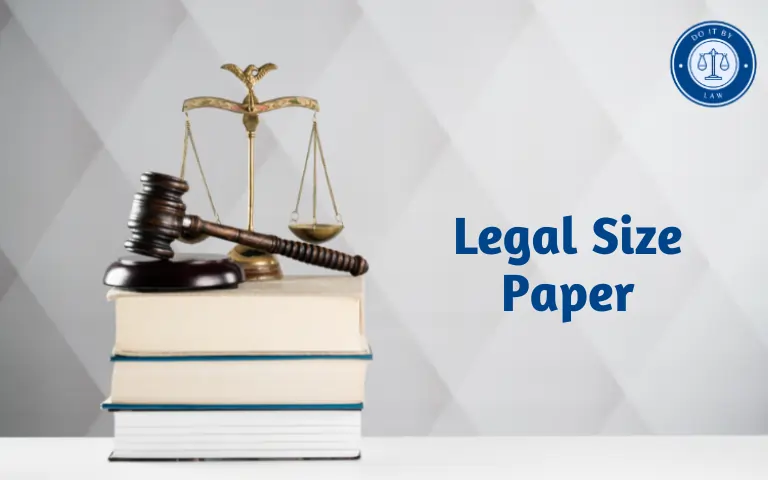Legal Size Paper: Complete Dimensions, Uses, Printing & Storage Guide
If you’ve ever printed or worked with documents like legal contracts, property records, or court filings, chances are you’ve handled legal size paper. But if you’re unfamiliar, you may wonder – what is legal paper size exactly?
This definitive guide will cover everything you need to know about standard North American legal paper size.
We’ll explore what makes it “legal” size, how the dimensions differ from regular letter size sheets, typical uses in legal and accounting documents, special considerations for printing and photocopying, ways to store the longer pages, and much more.
Let’s start by examining the key legal paper dimensions that make it unique.
A Brief History of Legal Size Paper
The origins of legal size paper can be traced back to the late 19th century when the American Bar Association (ABA) created wider, longer sheets to accommodate the denser text and annotations in early law journals and case reporters. Legal documents have traditionally required additional room for signatures, exhibits, codicils, and other lengthy attachments.
The ABA’s customized “legal” paper size stuck and was widely adopted by courts and law offices. Over time, as legal complexities grew, the legal community increasingly relied on these elongated pages.
Today the dimensions are standardized under American National Standards Institute (ANSI) guidelines for use across the US and Canada. The traditional letter size sheet common for letters and documents is just not quite big enough for many legal instruments.
Key Dimensions & International Size Comparison
Legal size paper gets its name from being the required paper size for legal documents filed in court systems or government offices in the U.S. and Canada. But what makes legal paper “legal sized”?
The ANSI technical drawing standard Y14.1 sets legal size paper at exactly 216 mm (8.5 inches) wide by 356 mm (14 inches) long. This results in a total area of 0.0765 square meters. Legal paper is the same width as ISO A4 and American letter size, but over 2 inches longer, providing substantially more writing space on the vertical axis.
Here is a comparison of dimensions across common international paper sizes:
| Paper Size | Width x Height (mm) | Width x Height (inches) |
|---|---|---|
| A4 | 210 x 297 | 8.3 x 11.7 |
| Letter | 216 x 279 | 8.5 x 11 |
| Legal | 216 x 356 | 8.5 x 14 |
So while legal sheets are identical in width to A4 and letter formats, the extended 14-inch length sets legal-size paper apart.
Why Is It Called “Legal” Size Paper? A Format Born Out of Function
Legal size might seem unnecessarily long at first glance. However, the origins of its dimensions reveal how the format evolved to suit key functions in law and court systems.
This paper size predates standard U.S. letter size. It has origins dating back to the 13th century when an early version called “foolscap” was used in courts and legal settings in England.
The story goes that a watermark depicting the fool’s cap emblem of a court jester was incorporated into paper produced for legal and governmental use. Hence the “foolscap” name.
As paper-making spread through Europe in the following centuries, this long sheet size became widely adopted for record-keeping and legal documents. The extra length better accommodated the lengthy text and multiple signatures or witness statements associated with early contracts and court rulings.
When paper formats were later standardized, countries like the U.S. and Canada chose to retain these same long sheet dimensions for all contemporary legal forms, record keeping, courts, and government agencies.
Hence why it remains known as “legal size” paper to this day – that original efficient format stuck and still suits legal work.
Next, let’s compare the legal size to standard letter paper more closely.
Typical Uses of Legal Size Paper
The most common uses of legal size paper and documents include:
- Legal Briefs: Case documents filed with courts use legal paper to accommodate sufficient arguments and evidence.
- Contracts: Extra length suits detailed contract terms, rights, responsibilities, and signatures.
- Corporate Documents: Legal sheets allow room for complexity in resolutions, meeting minutes, filings, and more.
- Real Estate Paperwork: Legal provides space for property outlines, deeds, title documentation, and exhibits.
- Wills & Estate Planning: Legal suits multi-page estate distributions and detailed inheritor information.
- Litigation Papers: Lawsuits and related documents use legal size for affidavits, discoveries, and research.
- Government Forms and Filings: Permit applications and other government documents are often on legal sheets.
Essentially any document with dense information and language tends to sprawl across legal-sized pages more gracefully than standard letter paper allows.
Key Benefits of Using Legal Size Paper
There are good reasons the legal and business world has standardized on legal paper dimensions for certain important documents:
- More Writing Space – The added length equates to more usable page space for text, margins, signatures, annotations, and footers. This suits legal writing.
- Professional Document Standards – Legal size meets conventions for binding and organizing critical documents.
- Clear Reading – Complex terms and details render better through ample line spacing and white space.
- Easier Editing & Updates – Length provides room for modifications and versioning without full rewrites.
- Consistent Formatting – Standard legal sheets lend uniformity to how documents are prepared, presented, shared, and stored.
- Reduced Paper Use – Condensing details on legal size ultimately saves paper over letter size.
Key Specifications of Legal Size Paper
Beyond dimensions, the legal paper has additional specifications that are good to understand:
- Paper Density: Typical weights range from 16 lb bond (60 gsm) to 28 lb bond (105 gsm) with 24 lb (90 gsm) being very common. Higher weights add durability.
- Brightness: Most contain bleach to reach white brightness levels of 92, 96, or 98. Brighter pages reduce eye strain.
- Texture: Legal documents use smooth, unfancy paper. Textures like vellum or linen would distort reading.
- Color: Bright white is standard, though cream is sometimes used for vintage legal aesthetics.
- Hole Punching: Many legal sheets come pre-punched for organized 3-ring binder filing.
- Printing: Must use high precision legal size printers and copiers to avoid cropping.
These qualities ensure professional, readable, durable legal documents.
Legal Paper vs. Letter Size – Key Similarities and Differences

Now that we know the origins and dimensions that define legal size paper, how does it compare to standard U.S. letter size – the sheets you likely use in your home and office printer regularly?
Let’s break down the key specs:
Comparing legal size paper dimensions vs letter size
Similarities:
- Both are equal in width at 8.5 inches or 216 mm wide.
Differences:
- The legal length is 14 inches (356 mm)
- The letter length is 11 inches (279 mm)
- Legal is 3 inches longer than the letter size
You can see that extra 3 inches clearly in the photo above – legal paper is noticeably longer than the standard letter sheet.
So in essence, legal paper size takes the common 8.5 inch width we’re all used to from regular printer paper and tacks on an extra 3 inches in length.
Understanding these key differences in dimensions helps explain why legal stands out from letter or A4 paper and lends itself well to certain professional document types.
Now let’s explore some best practices for printing and handling legal documents.
Printing Legal Size vs Letter Paper
If you need to print legal forms, what’s the process and what should you know about using longer 14-inch paper? While legal sticks to the standard 8.5-inch width, that extra 3 inches in length can catch printer trays unaware if they are set for typical letter size by default.
Key things to check for legal size printing:
- Tray length – Confirm your printer tray can fit 14-inch legal paper. Extend or expand if needed.
- Paper guide width – Adjust guides to the 8.5-inch width.
- Printer settings – Change paper size settings from letter to legal in menus.
To successfully print on legal-size paper, follow these guidelines:
- Document Page Setup: Adjust software page size to legal before formatting and writing. This avoids unexpected cropping or scaling issues.
- Printer Properties: Ensure printer settings reflect the legal paper size, tray selection, and paper type to match what’s loaded.
- Loading Orientation: Place legal sheets in landscape direction adjusted to the rear. Feed the 216 mm short edge first with 356 mm height trailing behind. Confirm
- Confirm Fit: Always test print one sheet first to check margins and alignment before printing entire jobs. With correct configurations, modern office printers and copiers handle legal-size paper seamlessly.
If your home printer has fixed trays unable to fit legally, print from a desktop office printer with adjustable trays or at a print shop instead.
Photocopying Legal Documents
What about making photocopies of legal forms – what steps should you take? Luckily most modern commercial photocopiers have adjustable trays to handle legal and other oversized documents.
When copying legally, follow the same principles:
- Confirm legal paper is loaded in the main tray
- Extend tray to 14-inch length.
- Adjust the width guides to 8.5 inches
- Set paper size to legal in settings
- Place the original legal document in the scanner
- Copy as normal
As with printing, if your small office copy machine can’t handle legal size, take documents to a print shop with larger, adjustable equipment.
Storing and Organizing Legal Size Paper
Another implication of the extra-long legal size dimensions comes up when storing printed documents or unused reams of legal paper.
At 14 inches long, legal sheets and stacks won’t fit in standard letter-size folders, binders, or filing cabinets. So, when managing legal forms and binders, be sure to use legal-specific storage sizes:
- File folders – Use legal document folders (with 14″ long sides)
- Filing cabinets – Designate a drawer for legal hangers and folders
- Binders – Opt for oversize 14″ legal binders
- Shelving – Install legal-size banker box shelves
Using these legal-formatted supplies keeps documents neatly organized and easy to store while preventing unsightly overflowing paper and binder drawers.
For unused reams of blank legal paper, you can stand boxes upright like letter paper. Just designate an area or shelf for legal stacks separate from the letter.
Proper legal paper storage might take some adjusting if you’re used to letter size. But a little planning goes a long way to keep those longer pages orderly!
Key Takeaways – What Makes Legal Paper Size Unique?
We’ve covered a lot of ground around the world of legal-size paper. To recap, the key things that characterize this format:
- North American legal size is 8.5 x 14 inches (216 x 356 mm)
- The same width as the letter size but 3 inches longer
- Originated from 13th-century “foolscap” paper used in English courts
- Dimensions standardized for legal documents and government records
- Works well for contracts, forms, big spreadsheets, posters, brochures, etc
- Requires legal print & copy settings
- Needs legal document storage and binders
So next time you come across those extra long legal sheets, you’ll know why 14 inches makes it the go-to paper for all things courts, law, contracts, and big documents!
FAQs About Legal Size Paper
Here are answers to some of the most frequently asked questions about legal-size papers:
Conclusion
Legal size paper has been the standard for legal documents in the US and Canada for over a century. At 216 mm x 356 mm (8.5 x 14 inches), these elongated pages provide ample writing space to accommodate contracts, courtroom filings, wills, corporate papers, and other lengthy legal instruments.
Understanding the background, dimensions, common uses, printing tips, and storage guidelines for legal-size paper ensures you can properly handle and format critical legal paperwork. With practice, legal documents can be drafted, printed, presented, shared, bound, filed, and archived with professionalism and ease.





